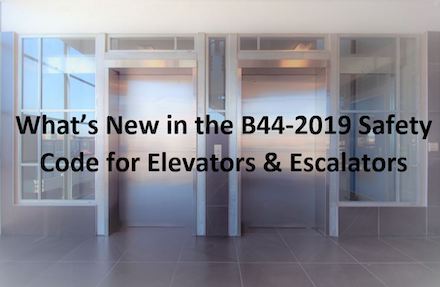What’s New in the B44-2019 Safety Code for Elevators & Escalators
In Ontario, the Technical Standards and Safety Authority (TSSA) regulates the adoption of the CSA B44 Safety Code for Elevators & Escalators. Currently, all new elevator installations in Ontario must comply with the 2010 edition of the B44 Code. However, new installations for which the signed contract date is after August 1, 2022 (and for some modernizations depending on their scope), the elevator will now have to comply with the 2019 edition of the B44 Code.
The B44-2019 edition brings some important regulation changes that impact the safety and cost of elevator systems.
For Owners
-
Emergency Communication Systems
Presently, elevators must have an in-car phone and activation push button. The B44- 2019 Code introduces requirements for an in-car message display and an in-car dedicated camera system. The message display allows emergency personnel to communicate and obtain responses from trapped passengers, including those who cannot verbally communicate or hear. The camera is to allow emergency personnel to observe passengers at any location on the car floor for entrapment assessment.
Thus, the complexity and cost of the emergency communication equipment is increasing. As well, in addition to the building-supplied phone line connections, the elevator must now connect to a building-supplied modem for an internet connection to display the in-car video feed to emergency personnel.
-
Door Re-Opening Device
Presently, elevators must have a door re-opening device that detects objects in the path of the closing door. This detection operates in two dimensions only. The B44-2019 Code introduces the additional requirement, beyond two dimensional protection, for the door re-opening device to detect approaching objects at a certain proximity from the elevator doors (i.e., three-dimension protection).
Thus, the complexity and cost of the door re-opening device is increasing.
-
Elevator Identification Tags
Presently, Appendix E requires that there be a raised character and braille floor
designation provided on both jambs of elevator hoistway entrances. The B44-2019 Code introduces the requirement to provide elevator identification tags directly below he floor designations at the main egress level, auxiliary egress level and floors with inspection and test panels.Thus, owners should consider how the elevator designation and the floor numbering overlap to minimize rider confusion.
For Designers/Architects/General Contractors
-
Pit Sump Pump/Drain Requirements
Presently, each elevator that is provided with Firefighter’s Emergency Operation must have a drain or sump pump that can remove a minimum of 11.4m3 (3,000 US Gal/h) of water. The B44-2019 Code modifies this requirement to indicate per single elevator or multiple hoistway.
Thus, building construction is simplified and costs reduced by making the requirement the same for a single elevator or a common hoistway with multiple elevators.
-
Testing and Maintenance of Fire Alarm Initiating Devices (FAIDs)
Presently, the fire system maintenance company must work together with the maintaining elevator contractor to inspect and test the FAIDs in the hoistway. The B44- 2019 Code introduces an option to provide a remote air sampling means for testing and maintenance.
Thus, while this could reduce the complexity of having to coordinate with the maintaining elevator contractor for testing, care must be taken in the design and location of the air sampling equipment so as not to interfere with elevator clearance requirements. Note that this does not remove the requirement to have the maintaining contractor on site during maintenance or service of FAIDs within the hoistway.
For Elevator Maintenance Contractors
-
Access to Equipment at Top of Hoistway
Presently, should an elevator become inoperable at the top of a single hoistway and require equipment access from the car-top, there is no simple way of gaining access. The B44-19 Code introduces the option to allow the in-car emergency access exit to be openable from inside the car to allow service personnel to access equipment from the car top.
Please contact us to discuss how these changes may impact your specific project.


 Schedule Fire Test
Schedule Fire Test

